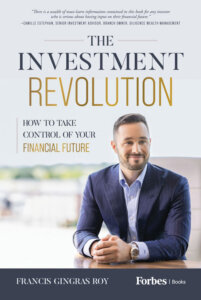Common risks to retirement, investing and financial freedom
In his book The Investment Revolution, Francis Gingras Roy writes a practical guide to achieving financial freedom.
Advertisement
In his book The Investment Revolution, Francis Gingras Roy writes a practical guide to achieving financial freedom.

No matter what stage of financial planning you are in, it is important to be aware of and understand the common risks to your retirement plan and financial stability. The Toronto Star published the following chart showing reasons why Canadians delay their retirement:
Results of a survey of Canadians older than 55 conducted in June 2022.
| I have delayed (or plan to delay) my retirement because… | |
|---|---|
| I don’t have enough savings/investments | 62% |
| Rising inflation/cost of living this year | 54% |
| I have too much debt | 40% |
| My children still require financial support | 26% |
| I love my job too much to quit | 23% |
| The COVID-19 pandemic | 21% |
| I am taking care of my partner/spouse | 13% |
| I am taking care of my partner or other family member | 10% |
The goal of this chapter is education, which, in my mind, is key to eliminating fear of the future. So, let’s look at some of these risks and what can be done to plan for each one.
While enthusiasm may be necessary for great accomplishments elsewhere, on Wall Street it almost invariably leads to disaster.
—Benjamin Graham
When people think of the word “inflation,” they naturally recognize it as an economic term. Inflation affects all aspects of our economy, and we’ll talk about this shortly. However, lifestyle inflation is just as important to discuss.
Think about this. You have been working for a particular company for several years, and you just got hired by another business that pays you a lot more; in fact, your take-home pay has increased 30 percent overnight.
The first thing you do is think of how you are going to spend that extra money: a new car, a larger home or apartment, a vacation, new clothes—the list is endless.
Lifestyle inflation is a simple equation that most people follow: The more you earn, the more you spend. It is termed “lifestyle inflation” because one’s standard of living goes up in relation to the income earned.
The problem is that people tend to spend like there is no tomorrow instead of saving for tomorrow. And in doing so, they shortchange their financial future.
For example, if you were to spend $500 of extra pay from your new job, you could cost yourself literally years of extra work. Consider that investing $500/month over ten years at an annualized 5% rate of return would net an extra $75,000.
Lifestyle inflation is a simple equation that most people follow.
The main problem associated with lifestyle inflation is that once spending habits are formed, they are hard to break or change. Our economy is debt-driven, meaning that people borrowing money to support their lifestyle is the driving force.
Lifestyle deflation that includes cutting back on spending, and developing a regular habit of saving and investing, is not something most people are excited about.
Let me be clear that I’m not against anyone enjoying what they earn. After all, a save-save-save mentality is what got Charles Dickens’s immortal character, Scrooge, into trouble.
But a constant mindset of “I deserve this” will never prepare anyone for a secure financial future. The adage, “Sacrifice today for a brighter tomorrow,” is a good way to curb lifestyle inflation. Here are four easy ways to combat lifestyle inflation:
Let’s say that you are committed to planning for your retirement and future financial stability. In this case, economic inflation must be taken into account. Inflation itself is much like the wind: you can feel its effects, but you cannot see it nor do you know when it is coming or going.
Consider the following charts from the Canadian Financial Consumer Agency. Inflation is the rising cost of consumer goods. It affects your retirement needs in two ways. First, the cost of the goods that you buy increases. Over 25 years, an inflation rate of 2.5% nearly doubles the cost of the goods you buy, as this chart shows.
| Number of years | If your annual expenses are $20,000 | If your annual expenses are $40,000 |
|---|---|---|
| 1 | $20,500 | $41,000 |
| 5 | $22,628 | $45,256 |
| 15 | $28,966 | $57,932 |
| 25 | $37,079 | $74,158 |
Second, it means that your savings lose value. Over 25 years, with an inflation rate of 2.5%, your savings lose nearly half of their value, as this chart shows.
(This does not take into account the turn on your investments—that is, the profit you make on any savings you invest.)
| Number of years | If your annual savings total $20,000 | If your savings total $40,000 |
|---|---|---|
| 1 | $19,512 | $39,024 |
| 5 | $17,677 | $35,354 |
| 15 | $13,809 | $21,576 |
| 25 | $10,788 | $21,576 |
With inflation both increasing the cost of the goods you buy and decreasing the value of your savings, you will need more money to maintain the same level of purchasing power over time. Take the rate of inflation into account when you project how much money you will need to cover your retirement years.
Inflation is measured with a tool called the Canadian Consumer Price Index. Statistics Canada compares year-over-year pricing on a range of products and services, such as food, housing and transportation to determine this index.
The Bank of Canada then uses its “key interest rate”—the rate the Bank of Canada charges banks to borrow money when they fall short of their required reserves—to influence the economy.
There are three “legs” to Canada’s retirement income system, the first two of which are indexed to the cost of living, meaning they pay a little more each year to help compensate for inflation:
Certainly, living a long and full life is the goal of every Canadian. However, the most often asked question of any investment advisor is, “Am I going to run out of money?”
The answer is no, because of federal and provincial plans that provide an income. However, what people are really asking is, “Can I afford my lifestyle throughout my lifetime?”
To answer this question, it is critical to do a cash flow analysis to understand future goals and the income needed to support those goals. Cash flow analysis includes projected income and debt and factors in products such as life and disability insurance.
Request a personalized quote and consult with an expert about your coverage needs. Get the protection you need at the right price.
We all know the stark reality that death is part of life, and making sure that financial investments are accessible to your loved ones through joint accounts or having a will is foundational to securing their financial future. Life insurance is also a major factor in relieving any financial burdens because of premature death. Keep in mind that reduced government spousal plan payments must also be accounted for.
| Permanent life insurance | Term life insurance | |
|---|---|---|
| What? | • Permanent life insurance is the right choice for individuals wanting a lifelong death benefit, the ability to use their policy in retirement, and the potential to build tax-deferred cash value over time. • This policy can cover final expenses, supplement retirement income, pay off debt, or fund other long-term goals. | • Term life insurance offers financial protection over fixed periods—usually 5 to 30 years, for a low, fixed cost. • A company will to pay the death benefit in exchange for on-time premium payments. If the policyholder dies before the term is over, the beneficiary receives the death benefit in a tax-free lump sum. If the policyholder is alive when the term ends, they can: cancel the policy if the coverage is no longer needed; renew the policy at their current age; convert part or all of the death benefit to a permanent policy, like whole or universal life |
| Who? | • It is convenient for individuals wanting a simple approach to covering inevitable expenses that will be incurred at some point during their life. • While the policy tends to be more expensive, the premiums stay consistent, making the policy easy to budgeting purposes. | • For those looking for value and affordability, or for temporary coverage that fits into their financial plan |
Every day, we wake up and think, “Nothing is going to happen to me today.” Yet, consider that “[r]esearchers estimated that there would be 233,900 new cancer cases and 85,100 cancer deaths in Canada in 2022.” And that’s just from one disease! Transport Canada reported that in 2020, there were 1,745 fatalities and 7,868 serious injuries reported from car accidents.
Statistically, Canadians are far more likely to get sick or injured than to die too soon. This shows the importance of having critical illness and/or disability insurance as part of a solid financial plan. The average cost for a disability insurance policy is 2%, and critical illness policies can be structured with different features and with term limits or level cost for life, so the question to ask is:
Would you rather get paid 98% of what you earn today and ensure you continue to receive that income in the event of a disability? Or are you a gambler and willing to bet that you won’t get sick or disabled?

Excerpted from The Investment Revolution: How to Take Control of Your Financial Future by Francis Gingras Roy, which is available on Nov. 12, 2024. He is a senior investment advisor at Manulife Wealth and a financial security advisor at Manulife Wealth Insurance Services Inc. Roy was named on Wealth Professional Canada magazine’s list of Canada’s Top 50 Advisors three times. The Globe and Mail recognized Roy as one of Canada’s top wealth management advisors in 2022.
Share this article Share on Facebook Share on Twitter Share on Linkedin Share on Reddit Share on Email